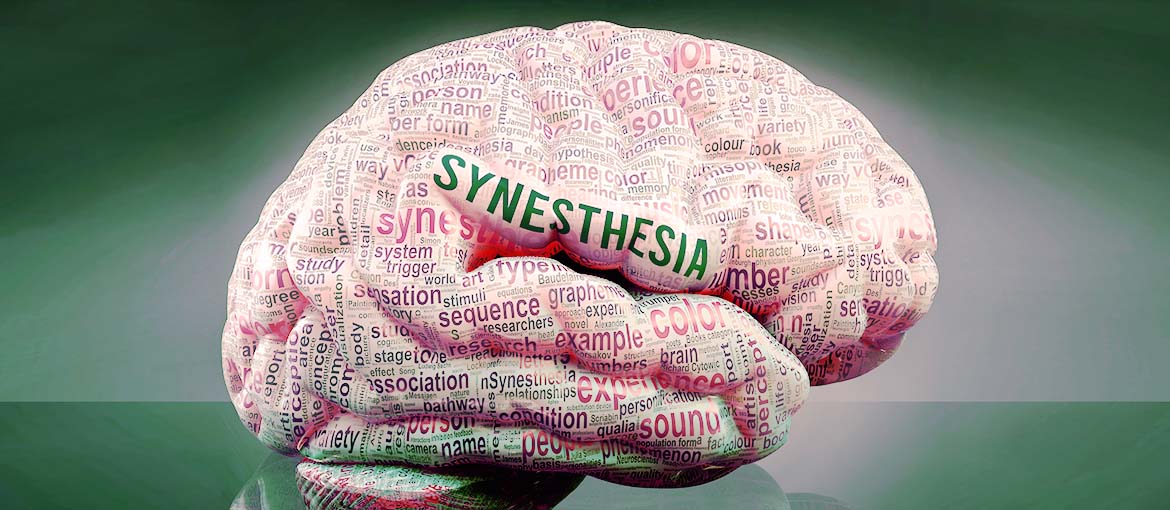Table of Contents
We’ve decided to investigate a fascinating phenomenon with plenty of mysteries still attached to it: synaesthesia, a rhetorical device used in the literary world and a sensory experience only available to a select few.
Synaesthesia: rhetorical and neurological meaning
Let’s begin with a definition of synaesthesia from the Treccani encyclopedia:
‘Synaesthesia (from the Greek sýn “with, together” and aisthánomai “I perceive, I understand”; together making “I perceive together”) is a rhetorical device, mostly used with metaphorical effect, that involves associating two words or two narrative sections relating to different sensory spheres in a single image.”
In other words, synaesthesia is a rhetorical figure involving a pairing of two words, usually a noun and an adjective, that belong to different senses. Synaesthesia could involve, for example, combining a noun that refers to the sense of sight (a colour) with an adjective describing the sphere of touch (warm or cold). This jarring association gives the reader a strong, somewhat poetic feeling of alienation. We’ll give you some more examples later on.
But that’s not all: synaesthesia is also a form of mental experience relating to the sensory – or rather multisensory – world. People with synaesthesia can connect, for example, a colour with a sound, a smell with a particular tactile sensation, or a sound with a shape. This ‘meeting of the senses’ can create some truly surprising associations. Few people can do it: some famous names from history with the condition included Pythagoras, who associated numbers with sounds, and Aristotle, who linked flavours, colours and sounds with touch.

Examples of synaesthesia, from literature to everyday speech
The rhetorical device is widely used in literature, and particularly in poetry, due to its powerful expressive potential. Here are a few examples:
- ‘The smell of red strawberries’ in Night-Blooming Jasmine by Giovanni Pascoli, which pairs smell and sight.
- ‘Shadowy blue voices’ in My Evening by Giovanni Pascoli, which pairs hearing and sight.
- ‘My fresh words’ in Evening at Fiesole by Gabriele D’annunzio, which pairs touch and hearing.
- ‘The sour smell of the wines in Saint Martin by Giosuè Carducci, which pairs taste and smell.
- ‘At the mother’s black scream’ in On the Branches of the Willows by Salvatore Quasimodo, which pairs hearing and sight.

As well as appearing in poetry, various examples of synaesthesia have entered the English language and become idioms, for instance:
- a warm or cold colour;
- warm or cold light;
- a course voice;
- a sweet or pungent scent;
- a sweet voice.
I’m sure you’ve used all of these in the past, probably without thinking about the sensory crossover you are creating.

Different forms of synaesthesia
As you’ll have realised, synaesthesia comes in various forms, based on the association of different senses. There is no single, universal way of classifying them, but here are a few common types:
- Grapheme-colour. This is one of the most common forms of synaesthesia, accounting for almost 70% of cases. It occurs when numbers or letters of the alphabet are associated with colours.
- Audio-visual. This occurs when a sound generates a visual stimulus like a colour or shape.
- Misofonia. When people associate specific sounds with negative emotions.
- Lexical-gustatory. When someone hears a word and associates it with a particular taste.
- Audio-tactile. When sounds are connected to sensations of touch.
- Personification of language. This occurs when letters, numbers or words are associated with a gender and personality.
You may be wondering while reading this list whether you have ever experienced any of these different types yourself. The condition is very rare, but if you would like to find out, you can visit the Synesthesia Battery website, which has a series of tests to find out if you have ever experienced synaesthesia and if so, which type. Go and have a browse!

